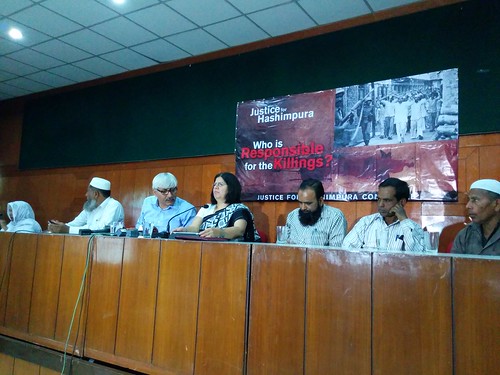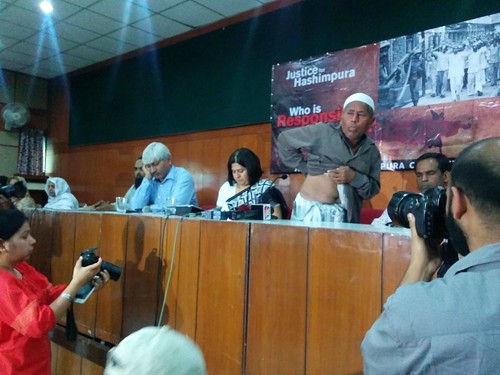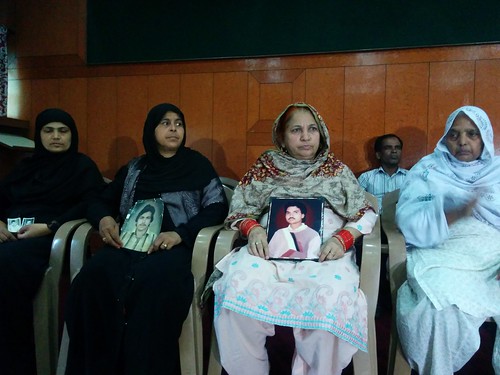By M Reyaz, TwoCircles.net,
New Delhi: The March 21 judgement in the 1987 Hashimpura massacre is a “slap” and “sad commentary not only on the social fabric of the country, investigating agencies, but also on the judiciary,” Advocate Rebecca M John, one of the senior counsels for the defence, believes.
John was speaking on Tuesday, March 24 at a public meeting held in the capital’s Indian Social Institute, where her colleague advocate Vrinda Grover along with several concerned civil rights activists also expressed their dismay. Those present included Wajahat Habibullah, former chairman of the National Minority Commission and member of the Commonwealth Human Rights Initiative (CHRI), Justice (retd) Rajinder Sachar, Professor Kamal Mitra Chenoy, John Dayal, Professor Apoorvanand, Harsh Mander and Tapan Bose among others.
Sixteen Provincial Armed Constabulary (PAC) personnel were acquitted by a court in Delhi on Saturday, March 21, in the 1987 Hashimpura massacre case. A total of 19 PAC personnel, three of whom have since died, were facing trial for allegedly killing 42 people in Hashimpura Mohalla of Meerut in Uttar Pradesh on May 22, 1987.

Witnesses in the case, those who survived the bullets and police atrocities, as well as the kins of the deceased were also present, several of whom shared the harrowing tale of the fateful night of May 22, 1987.
Professor Apporvanand began the programme wondering: “What faith minorities, and Muslims in particular would have in the government institutions and the judicial system if even after 28 years, it fails to deliver justice?” He reminded that on the one hand, Home Minister Rajnath Singh reiterates at different forums that the Muslims’ patriotism cannot be suspected, but on the other hand, he is doing little to restore their faith in the system.
Grover, who has been fighting for justice for the Hashimpura victims for over a decade now, said, “It is not an accidental injustice.”
“It is a very disappointing judgement. Judiciary failed to understand the state’s role and shied away” from making the investigating agencies and the state “accountable”, she said.
Justice Sachar, who as the president of PUCL, had led a fact finding committee to Hashimpura in June 1987, a month after the gruesome incident, revisited the ‘facts’ as he had gathered and written in the report. He termed the incident “most shameful,” suggesting that such a heinous crime cannot be conducted without some form of “decisions from the government to terrorise the people of Hashimpura.”
In fact, according to the then media reports, what had happened few days before the Hashimpura massacre incident gives credence to the theory that “the ‘operation’ was done to teach a lesson to the Muslims of the locality.” According to the cover story (June 15, 1987) carried by India Today, as the PAC personnel had gone to arrest some accused in Mohalla Hashimpura in a murder case, local residents had resisted since it was the time of iftar (in the holy month of Ramadan). This had resulted in a scuffle that gave way to communal tension.

From the testimonies of the witnesses, kin of victims, as well as media reports it was clear that abled youth, men between 12 to 50 years were segregated, packed into trucks and taken to Muradnagar, where they were fired upon and thrown one by one in Hindon River. During the same period, over two dozen were killed in Maliyana, few kilometres from Meerut.
The families of Mohalla Hashimpura, whose men were shot dead; and the five survivors, of one of the worst custodial communal killings in Independent India expressed their anguish, suffering and outrage at the judgment of the Delhi Trial Court that acquitted all the accused policemen of the Provincial Armed Constabulary (PAC).
At the programme, Justice Sachar also read from the letter which he had written to the then Uttar Pradesh Chief Minister Vir Bahadur Singh. He wrote that this is “too serious a matter to treat it with leisure,” urging him for impartial judicial enquiry and adequate compensation.
Several speakers also raised the issue of Gyan Prakash Committee Report that the state government has not yet tabled in the Assembly and hence not made public.
Advocate Grover reminded that none of the 19 PAC jawans were suspended for more than one and an half years, and instead, some were suspended for as little as six months. She said that despite murder charges against them, they were all reinstated and granted several promotions. She also added that the internal departmental annual confidential report (ACR), which they got through RTI, never once mentioned the case, but regarded them as “disciplined.”
Speakers questioned the successive state governments for their failure to deliver justice, and pointed at how investigations from very beginning were ‘botched up’ to weaken the case and protect the PAC personnel.
Wajahat Habibullah said it is a matter of concern not only for Muslims or minorities but for all right minded people that the judicial processes are not able to deliver justice even after such a long period. Pointing that it is the combined failure of the central and state government as well as judiciary, he urged the current central government to take measures as it talks of maximum governance. On behalf of his organisation, CHRI, he extended all possible help and assured cooperation.

Speakers raised pertinent questions as to “Why the accused could not be identified and whose responsibility was it?”; “Why did the investigating agency CBCID fail to even uncover the criminal conspiracy?” Advocates reminded that it was only in 1996 that the charge sheet was filed and that in 2002, the apex court shifted the case to Delhi as there was little progress in it in Uttar Pradesh.
Grover pointed out how at each stage a fair, rigorous and impartial investigation was systematically thwarted. The material pieces of evidence, both documentary and ocular, were either not collected, or destroyed, or allowed to disappear.
“This was not an accidental lapse, rather a pre-meditated omission and criminal negligence designed to dilute the prosecution case and shield the accused,” she said.
John said she was aware of some limitations in evidence (due to failure of the investigating agency), but pointed that the court has accepted that the massacre did take place and was hence disappointed at the judgement as “the court failed to understand the magnitude of the crime.” She added that the judiciary needed to take a bold position on this so that repetitions of such heinous crimes do not occur.”
Habibullah, Bose, Uma Chakravarty, Mander, Shabnam Hashmi, Kavita Krishnan, Dayal, Chenoy and Usha Ramanathan among others also compared the event of Hashimpura with those that happened at Muzaffarnagar, Kandhamal, Gujarat, etc. and underlined the alarming consequences of the systemic failure of criminal justice system. They pointed out that the injustice for Hashimpura victims was part of a growing pattern where victims of vulnerable, minority and marginalized communities such as Muslims, Christians, Dalits, Adivasis are being denied justice for the atrocities committed on them, which can have serious implications for India’s democracy.

